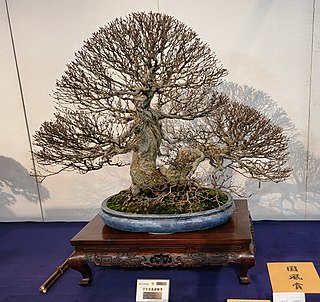
Hornbeams are hardwood trees in the plant genus Carpinus in the family Betulaceae. The 30–40 species occur across much of the temperate regions of the Northern Hemisphere.

Carpinus betulus, the European or common hornbeam, is a species of tree in the birch family Betulaceae, native to Western Asia and central, eastern, and southern Europe, including southern England. It requires a warm climate for good growth, and occurs only at elevations up to 1,000 metres (3,281 ft). It grows in mixed stands with oak, and in some areas beech, and is also a common tree in scree forests. Hornbeam was also known as yoke elm.

Carpinus caroliniana, the American hornbeam, is a small hardwood understory tree in the genus Carpinus. American hornbeam is also known as blue-beech, ironwood, musclewood and muscle beech. It is native to eastern North America, from Minnesota and southern Ontario east to Maine, and south to eastern Texas and northern Florida. It also grows in Canada. It occurs naturally in shaded areas with moist soil, particularly near the banks of streams or rivers, and is often a natural constituent understory species of the riverine and maritime forests of eastern temperate North America.

Gracillariidae is an important family of insects in the order Lepidoptera and the principal family of leaf miners that includes several economic, horticultural or recently invasive pest species such as the horse-chestnut leaf miner, Cameraria ohridella.

Carpinus japonica, the Japanese hornbeam, is a hornbeam endemic to Japan but cultivated elsewhere as an ornamental.

Phyllonorycter esperella is a moth of the family Gracillariidae. It is found from Sweden to the Pyrenees, Italy and Greece and from Great Britain to Ukraine.

Phyllonorycter tenerella is a moth of the family Gracillariidae. It is found from Sweden to the Pyrenees, Italy and Bulgaria and from Great Britain to north-western Russia and Ukraine.

The European oak leaf-miner or Zeller's midget is a moth of the family Gracillariidae. It is found in Europe south of the line running from Ireland, through Great Britain, Denmark to Ukraine. It is also found in Macaronesia. It is an introduced species in New Zealand and Australia.
Parornix carpinella is a moth of the family Gracillariidae. It is found from Sweden to the Pyrenees, Italy and Greece and from Great Britain to Russia.
Dialectica geometra is a moth of the family Gracillariidae. It is known from Hong Kong, Japan, India and Réunion. It has recently been recorded from China.
Phyllonorycter carpini is a moth of the family Gracillariidae. It is known from Japan (Hokkaidō) and the Russian Far East.
Phyllonorycter hikosana is a moth of the family Gracillariidae. It is known from Kyūshū island of Japan.
Phyllonorycter japonica is a moth of the family Gracillariidae. It is known from Japan and the Russian Far East.

Cameraria corylisella is a moth of the family Gracillariidae. It is known from Manitoba, Ontario, and Quebec in Canada, and Kentucky, Wisconsin, Maine, New York, Connecticut and Vermont in the United States.
Caloptilia ostryaeella is a moth of the family Gracillariidae. It is known from Québec, Canada, and Kentucky, Maine, Ohio and Vermont in the United States.

Ypsolopha parenthesella is a moth of the family Ypsolophidae. It is found from Europe to Japan, as well as north-eastern China, Asia Minor and mideast Asia.

Gracillariinae are a subfamily of moths which was described by Henry Tibbats Stainton in 1854.
Acleris delicatana is a species of moth of the family Tortricidae. It is found in China, Japan and Russia (Siberia).

Carpinus cordata is a species of flowering plant belonging to the family Betulaceae.

Carpinus turczaninovii, the Turczaninow hornbeam or Korean hornbeam, is a species of flowering plant in the family Betulaceae, native to central China, the Korean Peninsula, and central and southern Japan. It is a large shrub or small tree typically 15 to 20 ft tall and about 75% as wide, and is hardy to USDA zone 5b. It is available from commercial suppliers, and can handle very hard pruning.









